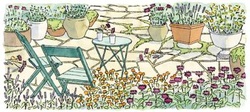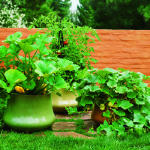
http://www.motherearthnews.com/natural-health/natural-mosquito-repellents-zm0z12jjzhun.aspxBy Ellen Sandbeck
Enlarge Image
Your outdoor spaces will be clear of mosquitoes if you plant one or more of these natural mosquito-repellent plants.
ILLUSTRATION: CHRISTINE ERIKSON
Summertime, and the living is ... too mosquitoey and itchy? It’s a common complaint. And mosquitoes are not only a nuisance — they can also spread West Nile virus.
Wearing loose, light-colored pants and long-sleeved cotton shirts is helpful in fending off mosquitoes. On particularly muggy and buggy days, you can wear a head net, though sometimes that’s more than one can bear.
For many people, the solution is to reach for a DEET-based repellent before venturing outdoors. DEET has been around for more than 50 years, and the Environmental Protection Agency has assured us this chemical is safe if “used as directed.” DEET has been the standard against which all other repellents are measured — but is it really safe?
A 2001 review of 17 cases of suspected DEET toxicity in children concluded that “Repellents containing DEET are not safe when applied to children’s skin and should be avoided in children. Additionally, since the potential toxicity of DEET is high, less toxic preparations should be substituted for DEET-containing repellents, whenever possible.” In 2009, a French study reported that “Excessive doses of DEET could be toxic to humans and could cause severe seizures and lethality when combined with other active ingredients, such as pesticides.” The French researchers (read their full report at BMC Biology) studied DEET’s effects on insect, mouse and human proteins and showed that the chemical disrupted the action of acetylcholinesterase, a key enzyme in the central nervous system of insects and mammals — including humans.
The thought of slathering on a neurotoxin scares many of us, so the editors at MOTHER EARTH NEWS and I explored the research on natural mosquito repellents (there is a ton of it!) and put together this report on natural alternatives to DEET. To make our list of effective, nontoxic options, a natural mosquito repellent had to meet two requirements:
1) The material(s) involved needs to be “Generally Recognized as Safe” (GRAS), and be nonhazardous to people, pets and other non-mosquito living beings.
2) Repellents and techniques have to be scientifically proven effective.
After careful research, we landed on two attractive options: homegrown mosquito-repellent plants and homemade mosquito traps.
Natural Mosquito Repellents: What Works, What Doesn’tAlmost everyone has seen newspaper or magazine ads for the “Mosquito Plant,” a hybrid geranium (Pelargonium citrosum) whose very presence, according to the ads, will chase mosquitoes off of your patio. A search of the literature revealed no scientific evidence backing this claim. In fact, one research study conducted at Florida A&M University showed that mosquitoes were completely unfazed by these plants, landing readily on their leaves and feeding enthusiastically on human volunteers sitting next to the plants.
Garlic is another well-known “mosquito plant.” Research shows that garlic does have a moderate repellent effect if rubbed on the skin, but there are more effective options available that also have a more pleasant odor. Eating garlic has not been shown to be effective at repelling mosquitoes.
Luckily, for those of us who prefer not to spray or rub ourselves with garlic or synthetic chemicals, several other plants passed repellency tests with flying colors and fleeing mosquitoes. Our top five mosquito-repellent plants — rose-scented monarda, lime basil, catnip, sacred basil and thyme — are detailed in “Grow Your Own Mosquito-Repellent Plants” further along in this article. All of these plants should thrive throughout most of North America and would make a lovely display on or near your patio or deck.
You can use these plants as natural mosquito repellents in two ways: First, rub the fresh leaves on your clothes and skin when you head outside, and reapply as needed. Second, grow them close to the areas where you spend time outside, and toss small branches of the plants on your patio before picnics or other gatherings. As you and guests stroll over the branches, mosquito-repellent scents will naturally waft into the air.
Homemade Mosquito TrapsThough female mosquitoes need a blood meal in order to lay eggs, both male and female mosquitoes are fueled by flower nectar and fruit juice, and exciting new research from Israel and West Africa has discovered how to take advantage of these facts. Homemade mosquito traps baited with sugar and fermented fruit juice reduced local mosquito populations by 90 percent. Here’s how to make these mosquito traps at home.
Materials:
1/16-inch-diameter nail or drill bit
Quart-sized, large-mouth plastic container with lid
3 tsp sugar
1/2 tsp boric acid
1 cup smashed, fermented fruit with the fruit juice
Jasmine essential oil (optional)
Instructions:
Set smashed fruit in the sun for a day or two before making the homemade mosquito traps to speed up fermenting. Drill or punch several 1/16-inch holes in the container lid (the small holes will let mosquitoes in while excluding beneficial insects such as bees). Next, mix the ingredients in the container. Put the ventilated lid on the container. Place the trap outside in a sheltered location where it won’t get rained on.
Mosquitoes will feed on the sugary, fermented fruit juice laced with boric acid, which will kill them. We also found studies that showed that many mosquito species are attracted to the scent of jasmine, so try adding a couple of drops of jasmine essential oil to your mosquito traps.
North America is home to more than 100 species of mosquitoes, and some may be more attracted to these traps than others. As far as we have been able to determine, this type of trap has not yet been deployed in North America. As we went to press, we found additional details on another approach to homemade mosquito traps, which you can read in Low-Cost Homemade Mosquito Trap.
These traps and the natural mosquito-repellent plants probably won’t make your yard totally mosquito-proof, but they should help — and they sure beat exposing yourself to a now-proven neurotoxin. If you give these techniques a try, let us know how they work for you by posting a comment at the end of this article.
West Nile Virus StatusDramatic headlines notwithstanding, in 2011 there were only 690 reported cases of West Nile virus in the United States and 43 deaths from the virus. Only 20 percent of people who contract West Nile virus develop any symptoms at all, and, in most cases, these flu-like symptoms are mild.
Grow Your Own Mosquito-Repellent PlantsThe following five plants produce effective mosquito-repelling volatiles, but they release these compounds in large quantities only when the leaves are damaged. Pick and crush a few leaves from any of the plants, then rub the crushed leaves on your skin and clothing to discourage mosquitoes. If you have large enough plants, you can use stems and leaves as “strewing herbs” on your patio.
Rose-scented monarda is a colorful perennial especially rich in geraniol, a compound that smells like roses. Turns out, geraniol is highly repellent to mosquitoes, according to an Israeli study published in the Journal of Vector Ecology. Scientists at the Morden Research Station in Manitoba, Canada, have developed monarda hybrids for commercial essential oil production. The extracted oil of their variety now sold as rose-scented monarda contains more than 90 percent geraniol. Geraniol is the active ingredient in some commercial natural mosquito repellents.
Lime basil (Ocimum americanum, also called “hairy basil” and “hoary basil”) is a culinary and medicinal annual that’s an effective repellent when burned and when grown nearby.
Catnip (Nepeta cataria) is a perennial in the mint family. Nepetalactone, the essential oil that gives catnip its distinct smell, is more effective than DEET at repelling mosquitoes, according to laboratory research conducted by Chris Peterson, an entomologist with the U.S. Department of Agriculture Forest Service, and Joel R. Coats, former chair of the Department of Entomology at Iowa State University. Note: Some cats love catnip and some ignore it. If you have a catnip-lover, you may need to grow your catnip under a wire basket to keep your cat from killing the plant.
Sacred basil (Ocimum sanctum, also called “holy basil” and “tulsi”), an annual, has been used medicinally in South Asia for thousands of years. The leaf extract discourages mosquitoes from feeding, and the seeds, floated on water, kill mosquito larvae.
Thyme (Thymus vulgaris) is a low-growing perennial culinary herb. Researchers at Seoul National University in Seoul, South Korea, found that thyme volatiles repelled mosquitoes as well as or better than DEET, and that thyme volatiles lasted as long as DEET.
NOTE: A section of this article that recommended planting of lantana to repel mosquitos has been removed after editors learned that some sources report consumption of the plant can be toxic. Our thanks to the readers who brought this to our attention. — MOTHER
Sources for Natural Mosquito RepellentsSacred basil, lime basil and catnip
Fedco Seeds
Waterville, Maine
207-873-7333
Rose-scented monarda
Companion Plants
Athens, Ohio
740-592-4643
Thyme plants
Widely available at garden centers
I am currently growing catnip outside on the porch and in a planter next to the lawn chairs. We will see how it works, just now starting to bloom. I do not however have a huge mosquito problem at my home as much as other folks since I live close to the ocean and that slight breeze seems to reduce thier numbers. However......






 RSS Feed
RSS Feed